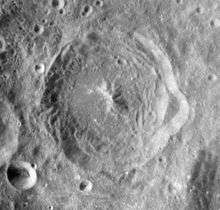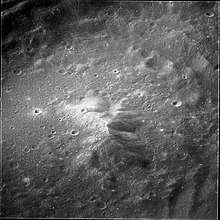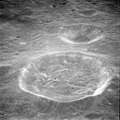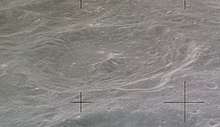Green (lunar crater)
Green is a lunar impact crater on the Moon's far side. It was named after British mathematician and physicist George Green in 1970.[1] Prior to that, it was designated Crater 216.[2] It lies just to the west of the huge walled plain Mendeleev, and is nearly joined with the west-northwestern edge of the crater Hartmann.
 | |
| Coordinates | 4.1°N 132.9°E |
|---|---|
| Diameter | 65 km |
| Colongitude | 228° at sunrise |
| Eponym | George Green |
Description
The crater has not been significantly eroded although a few tiny craterlets lie along the edge and inner wall. The perimeter is nearly circular, but has an outward bulge along the eastern side with some indications of a landslip. The inner sides display some terrace structures, particularly to the northeast. At the midpoint of the relatively level interior floor is a central ridge. The floor is more level along the western half, with some low rises in the east. There are only a few tiny craterlets on the interior.

Satellite craters
By convention these features are identified on lunar maps by placing the letter on the side of the crater midpoint that is closest to Green.
| Green | Latitude | Longitude | Diameter |
|---|---|---|---|
| M | 0.9° N | 132.9° E | 37 km |
| P | 1.0° N | 131.8° E | 21 km |
| Q | 2.8° N | 131.7° E | 16 km |
| R | 3.4° N | 131.0° E | 33 km |
 Green M crater from Apollo 11
Green M crater from Apollo 11
Green M crater has a ray system and is consequently mapped as part of the Copernican system.[3]
References
- "Green (lunar crater)". Gazetteer of Planetary Nomenclature. USGS Astrogeology Research Program.
- Lunar Farside Chart (LFC-1A)
- Stratigraphy of Lunar Craters, Don E. Wilhelms and Charles J. Byrne, January 23, 2009
- Andersson, L. E.; Whitaker, E. A. (1982). NASA Catalogue of Lunar Nomenclature. NASA RP-1097.CS1 maint: ref=harv (link)
- Bussey, B.; Spudis, P. (2004). The Clementine Atlas of the Moon. New York: Cambridge University Press. ISBN 978-0-521-81528-4.CS1 maint: ref=harv (link)
- Cocks, Elijah E.; Cocks, Josiah C. (1995). Who's Who on the Moon: A Biographical Dictionary of Lunar Nomenclature. Tudor Publishers. ISBN 978-0-936389-27-1.CS1 maint: ref=harv (link)
- McDowell, Jonathan (July 15, 2007). "Lunar Nomenclature". Jonathan's Space Report. Retrieved 2007-10-24.CS1 maint: ref=harv (link)
- Menzel, D. H.; Minnaert, M.; Levin, B.; Dollfus, A.; Bell, B. (1971). "Report on Lunar Nomenclature by the Working Group of Commission 17 of the IAU". Space Science Reviews. 12 (2): 136–186. Bibcode:1971SSRv...12..136M. doi:10.1007/BF00171763.CS1 maint: ref=harv (link)
- Moore, Patrick (2001). On the Moon. Sterling Publishing Co. ISBN 978-0-304-35469-6.CS1 maint: ref=harv (link)
- Price, Fred W. (1988). The Moon Observer's Handbook. Cambridge University Press. ISBN 978-0-521-33500-3.CS1 maint: ref=harv (link)
- Rükl, Antonín (1990). Atlas of the Moon. Kalmbach Books. ISBN 978-0-913135-17-4.CS1 maint: ref=harv (link)
- Webb, Rev. T. W. (1962). Celestial Objects for Common Telescopes (6th revised ed.). Dover. ISBN 978-0-486-20917-3.CS1 maint: ref=harv (link)
- Whitaker, Ewen A. (1999). Mapping and Naming the Moon. Cambridge University Press. ISBN 978-0-521-62248-6.CS1 maint: ref=harv (link)
- Wlasuk, Peter T. (2000). Observing the Moon. Springer. ISBN 978-1-85233-193-1.CS1 maint: ref=harv (link)
